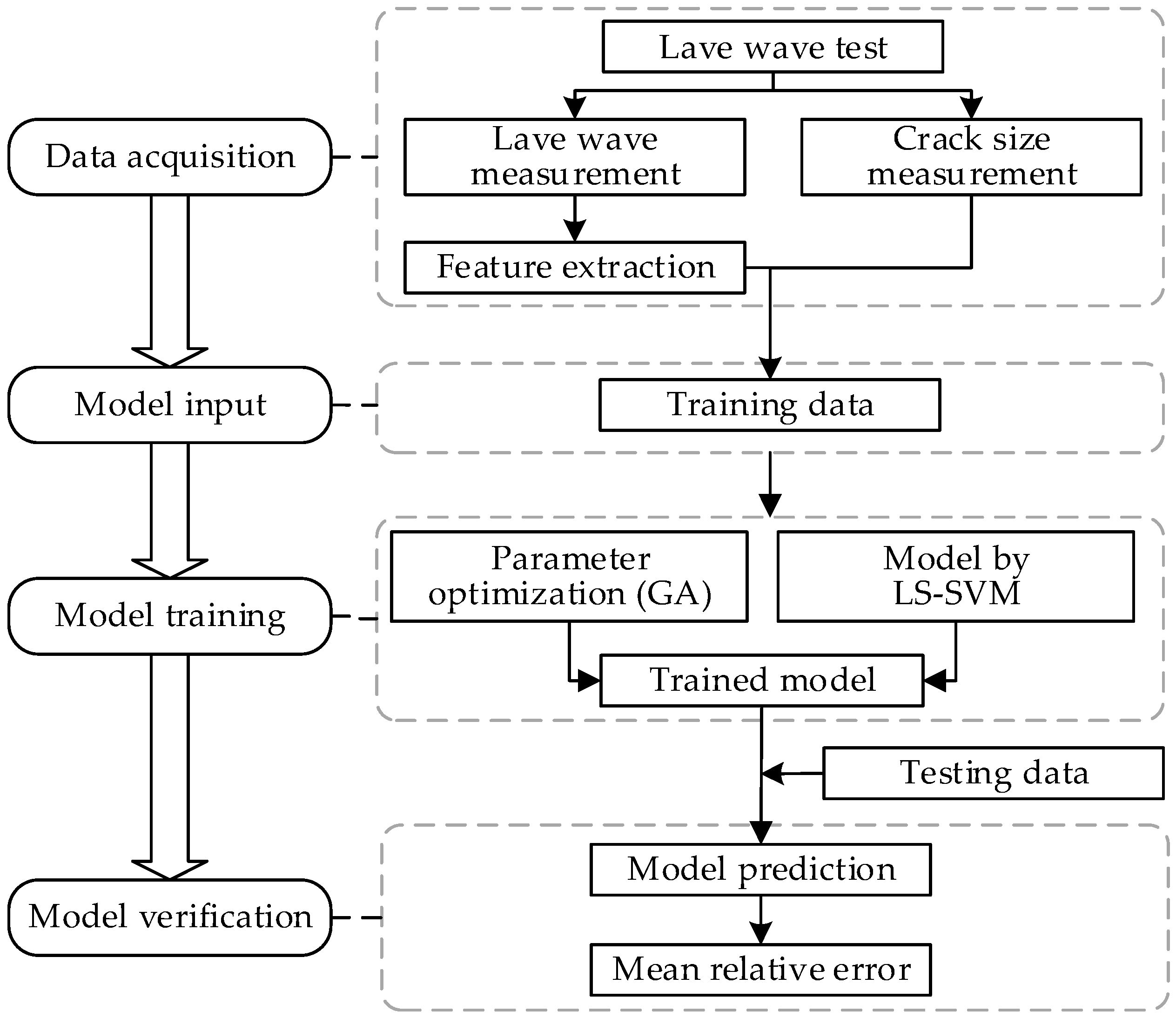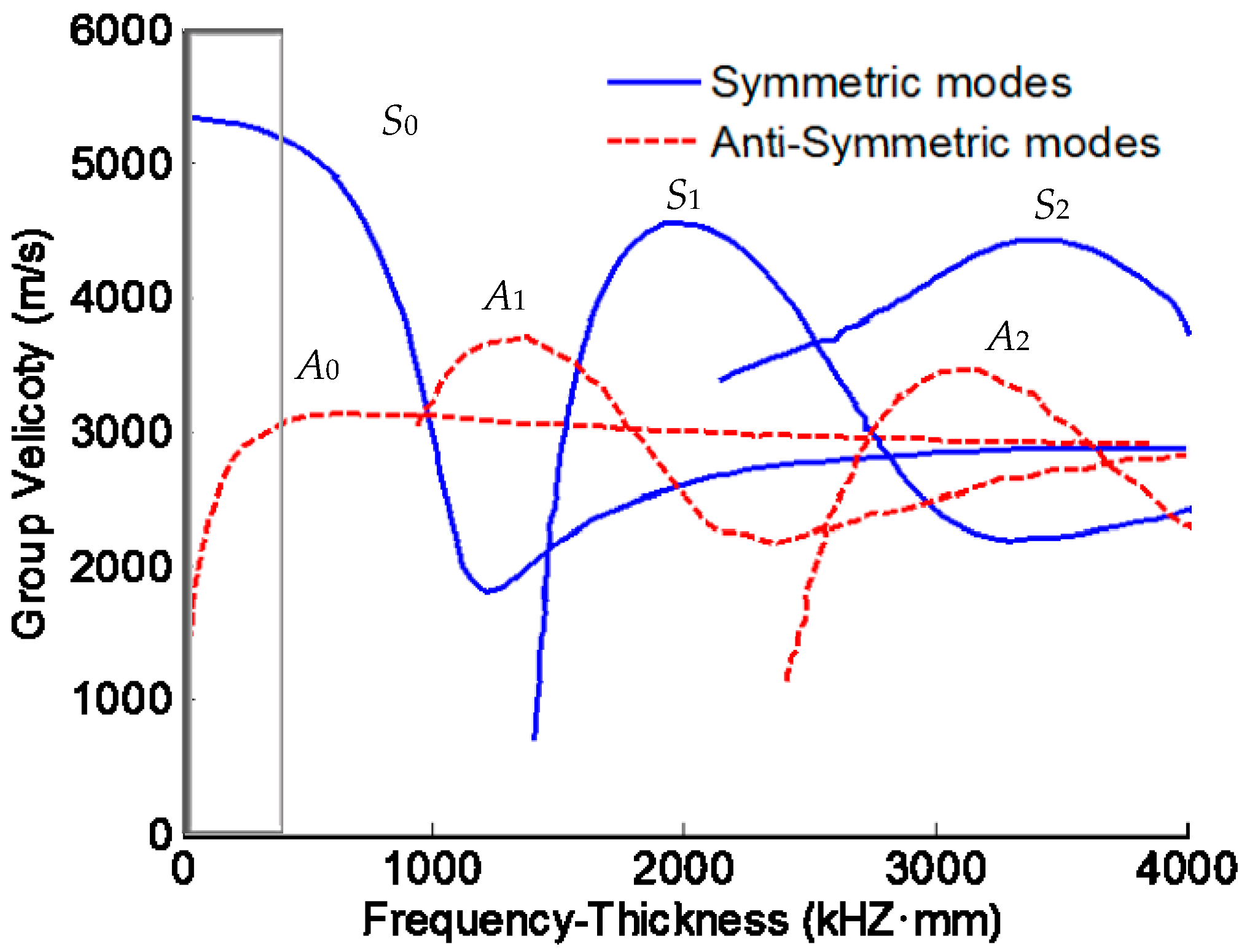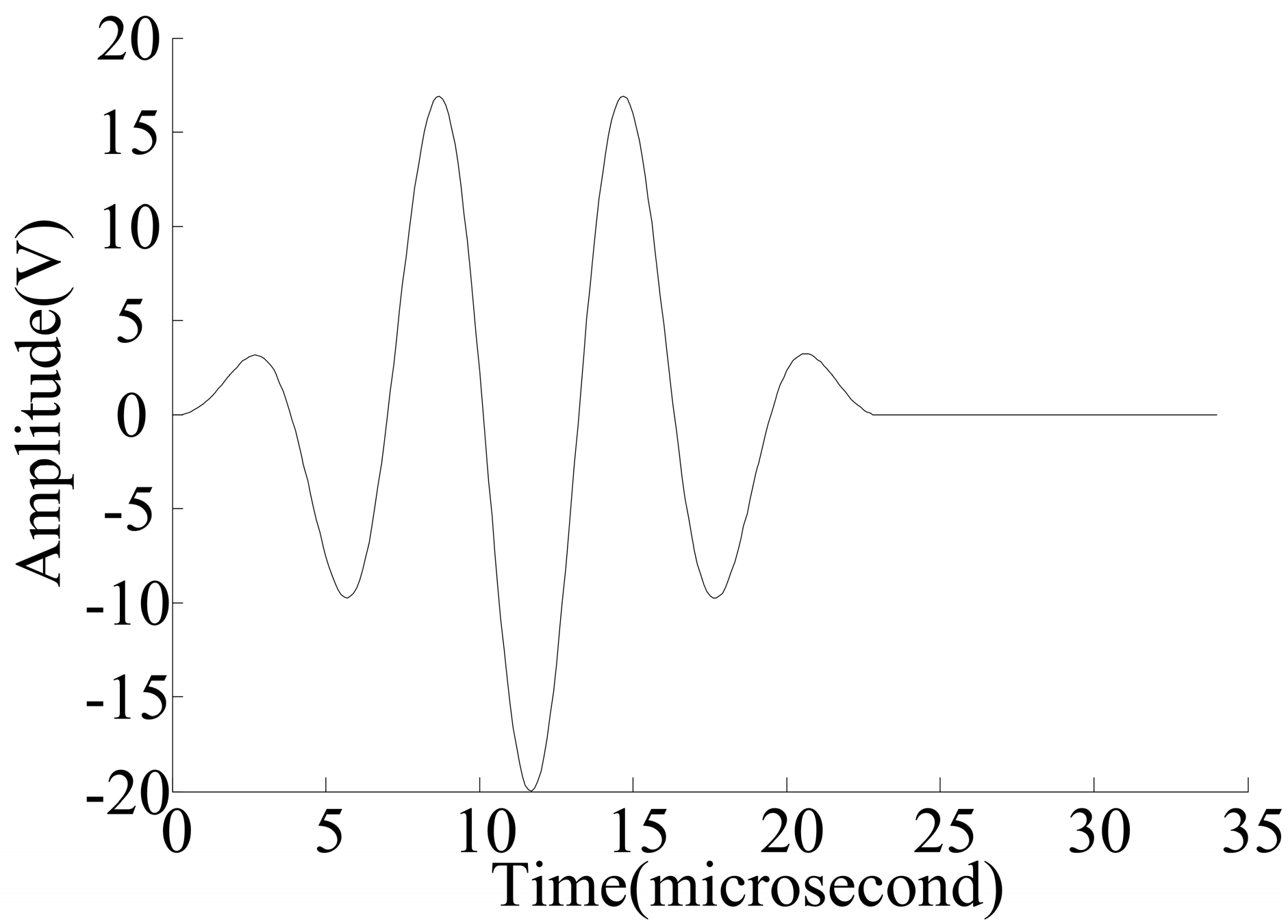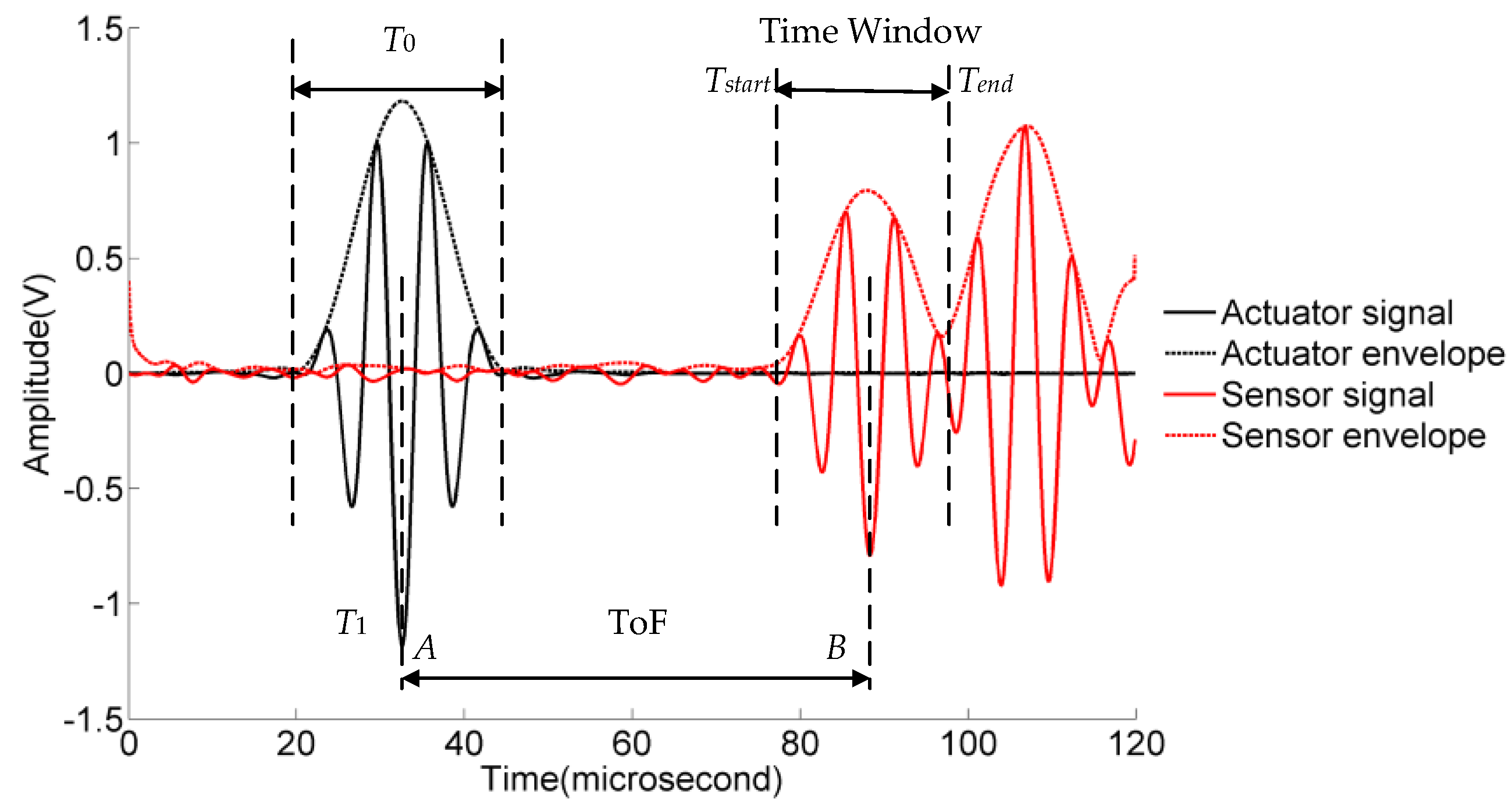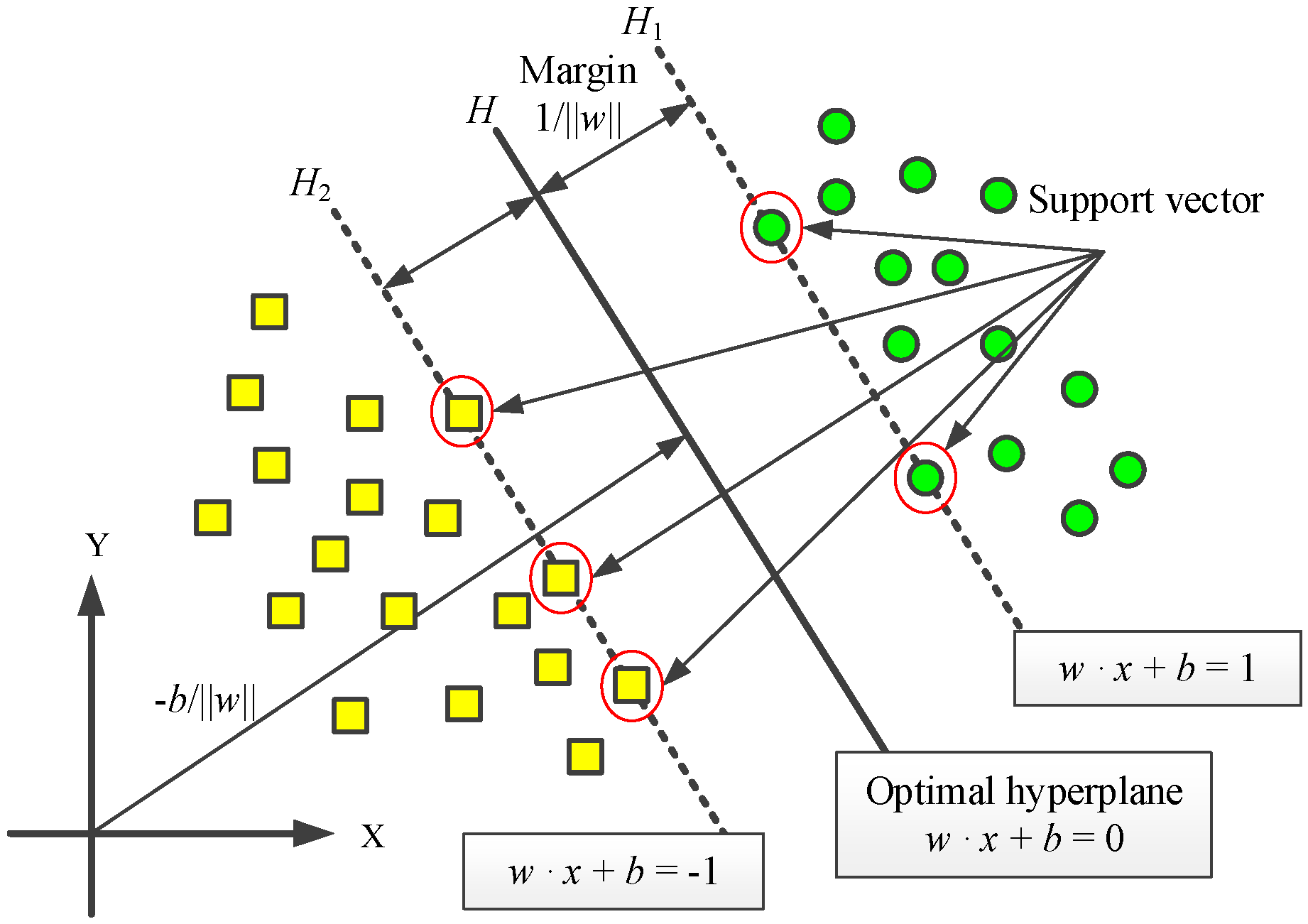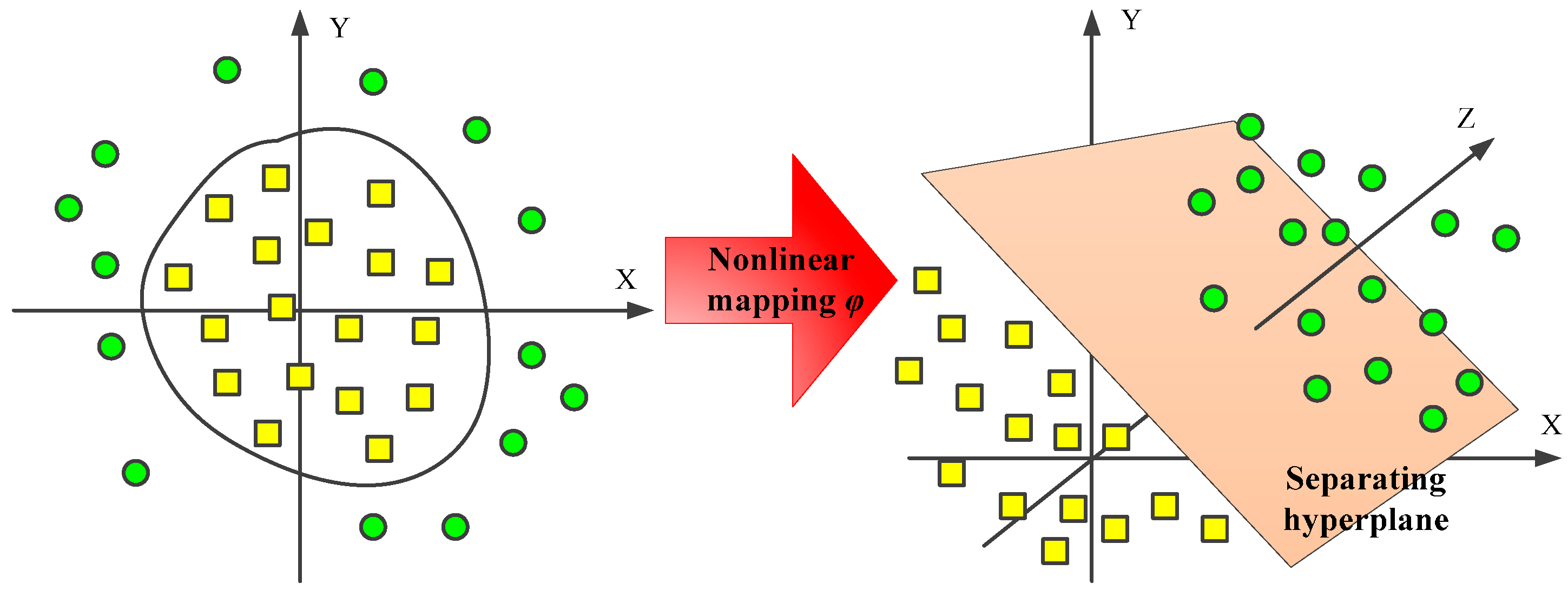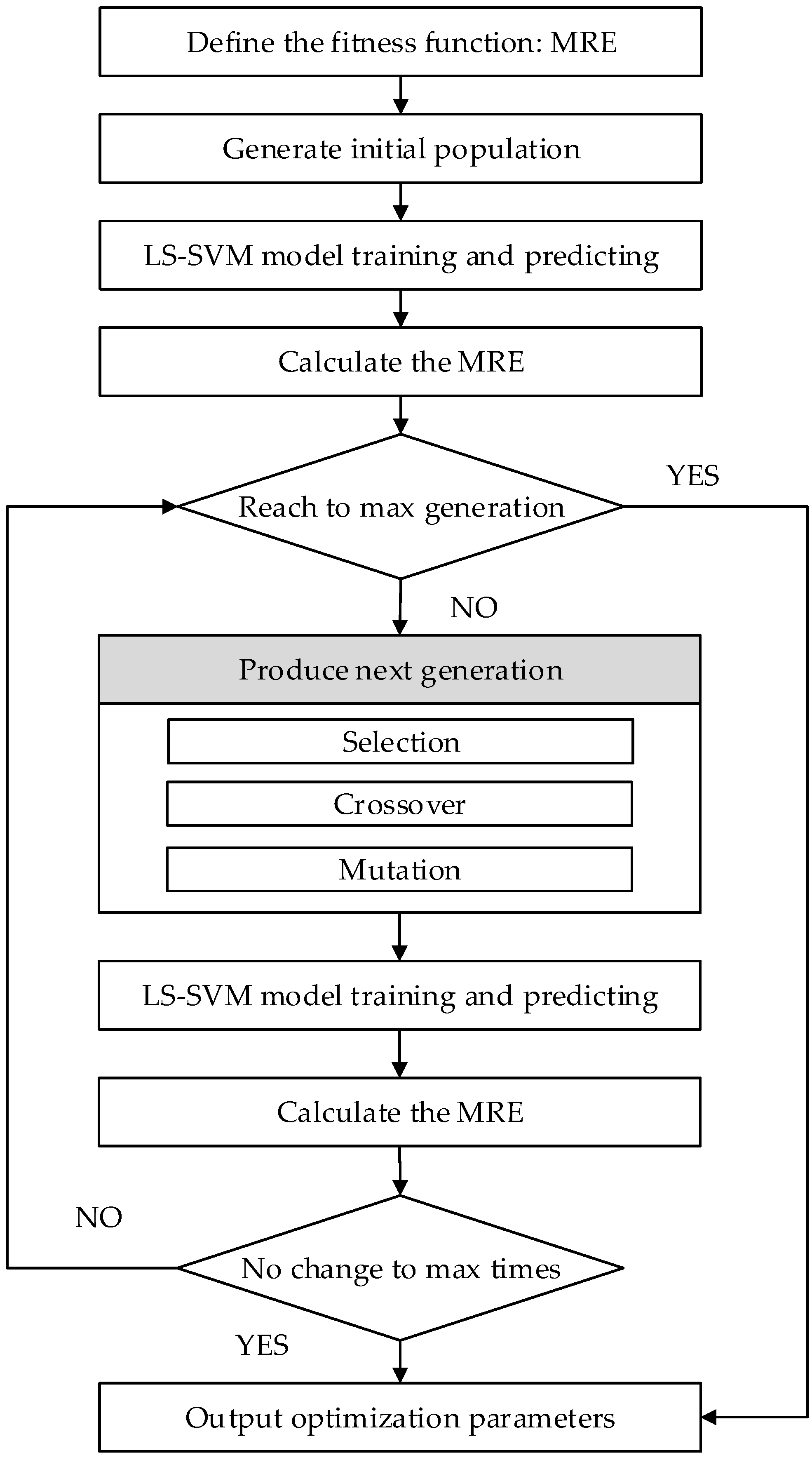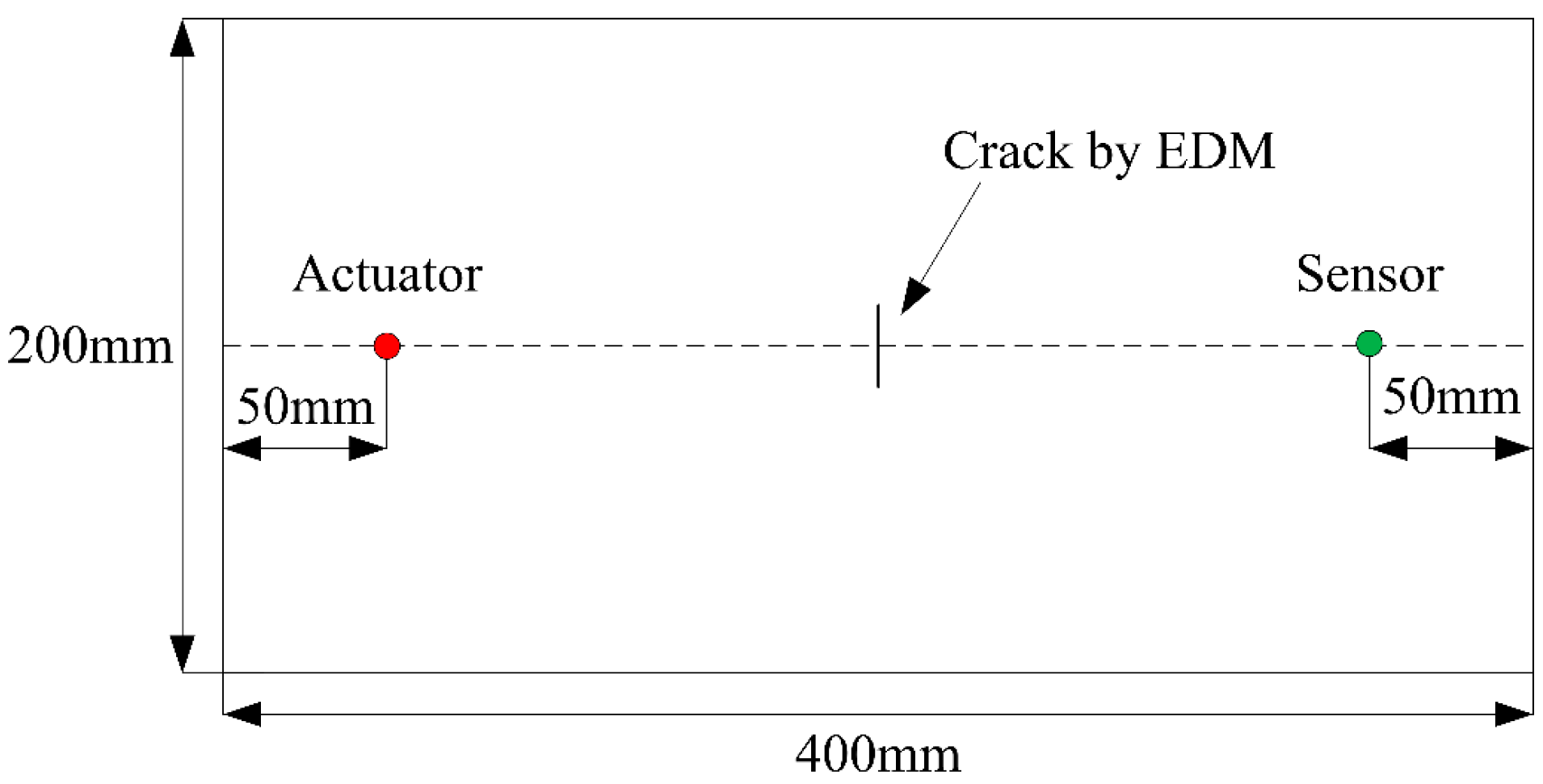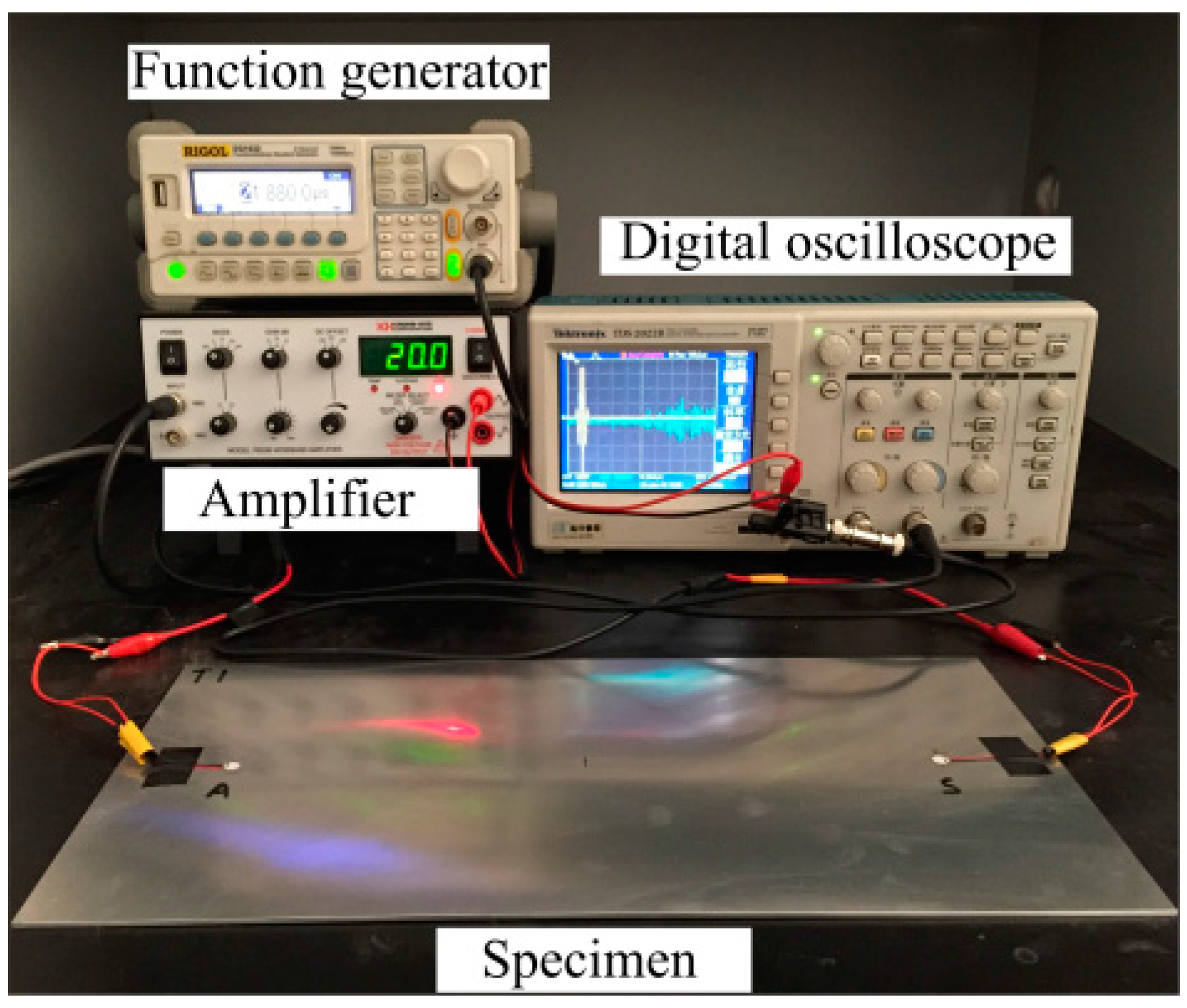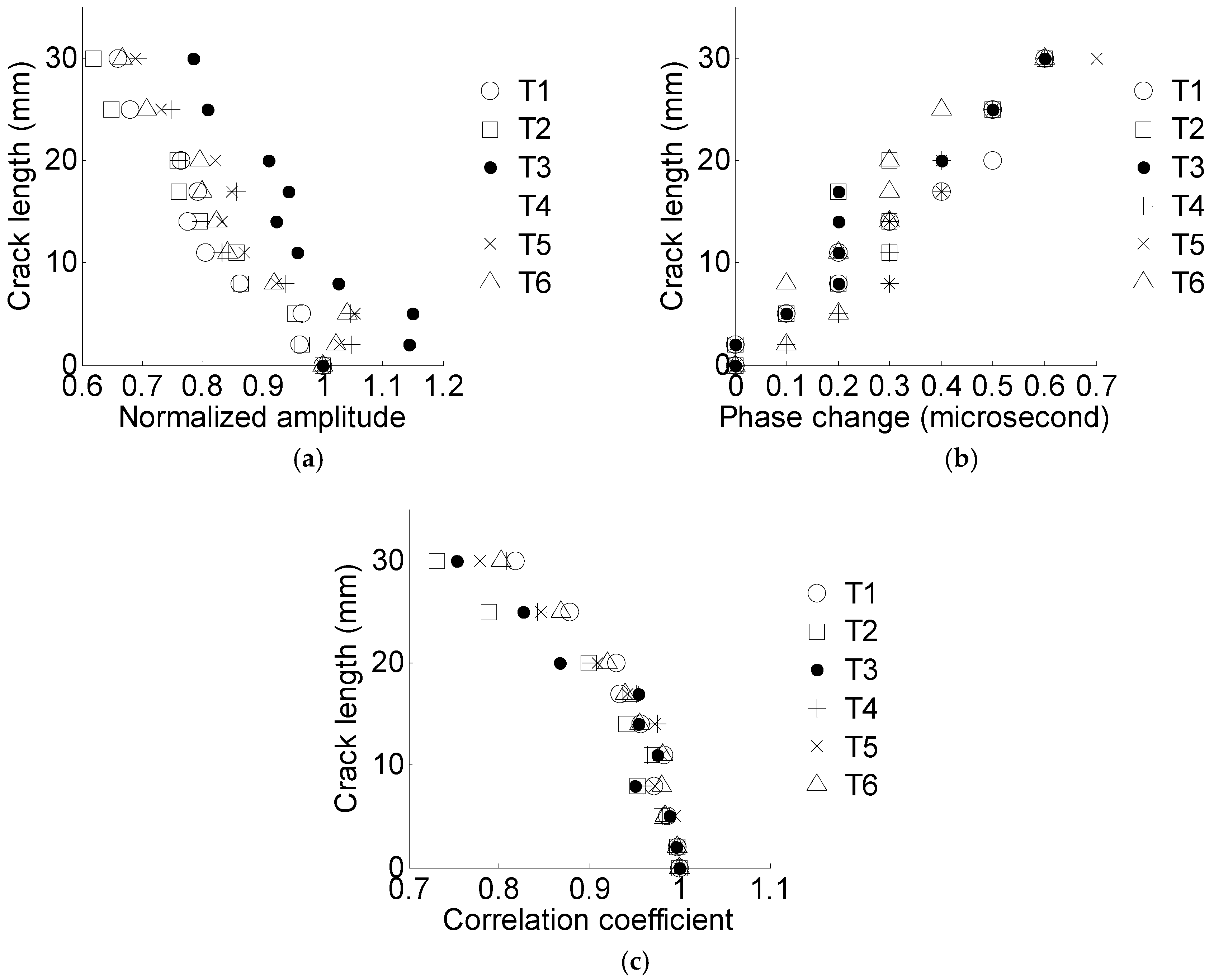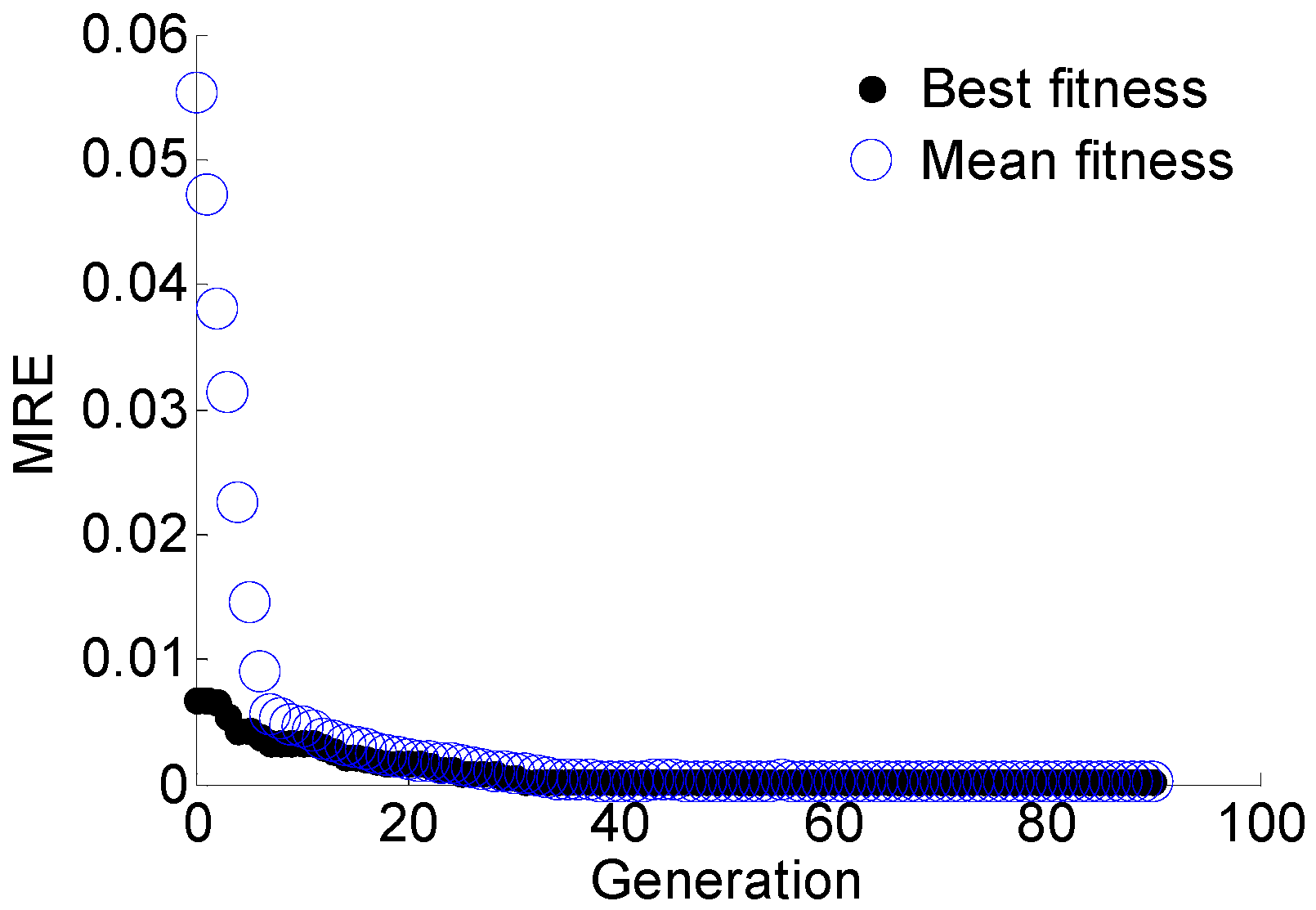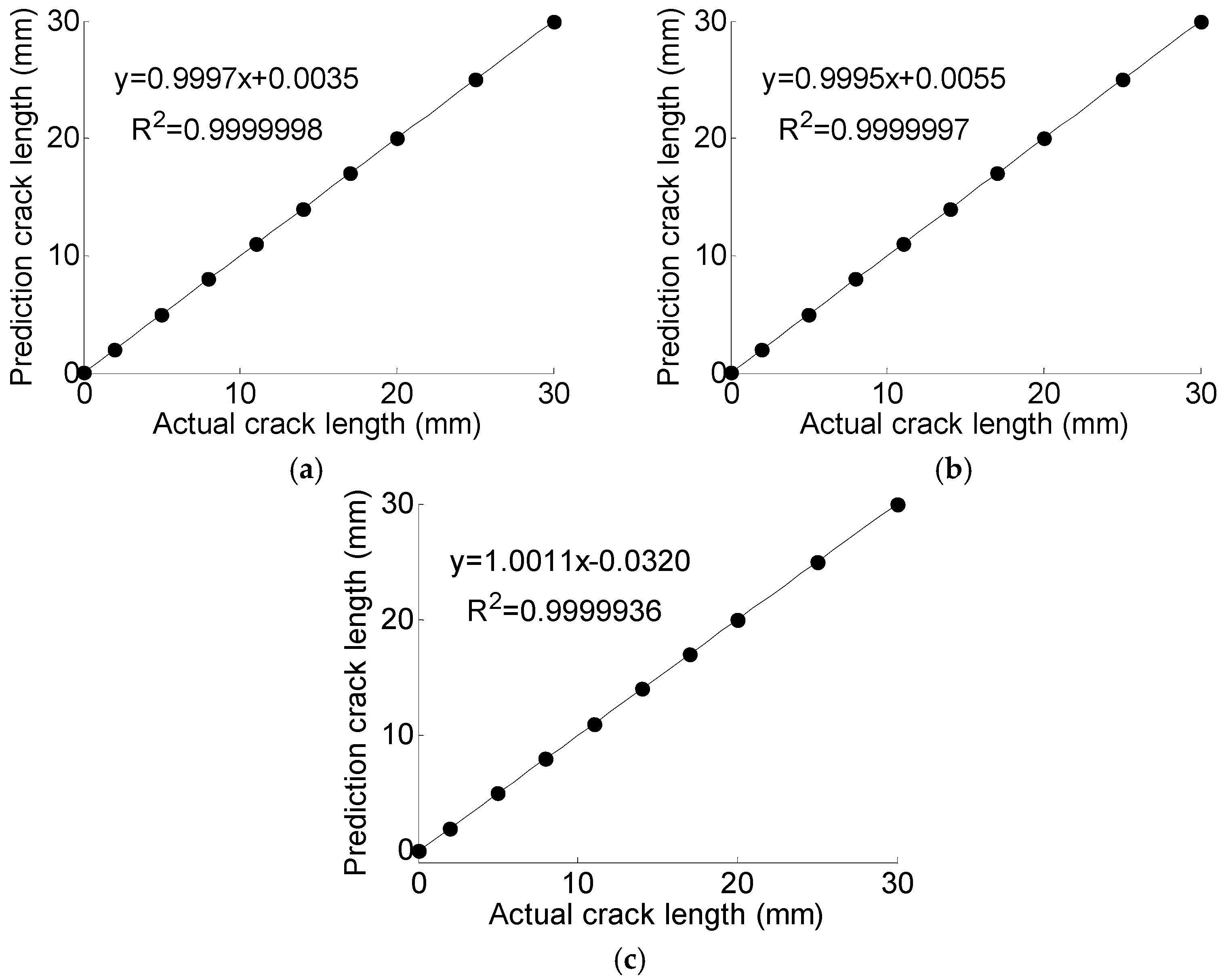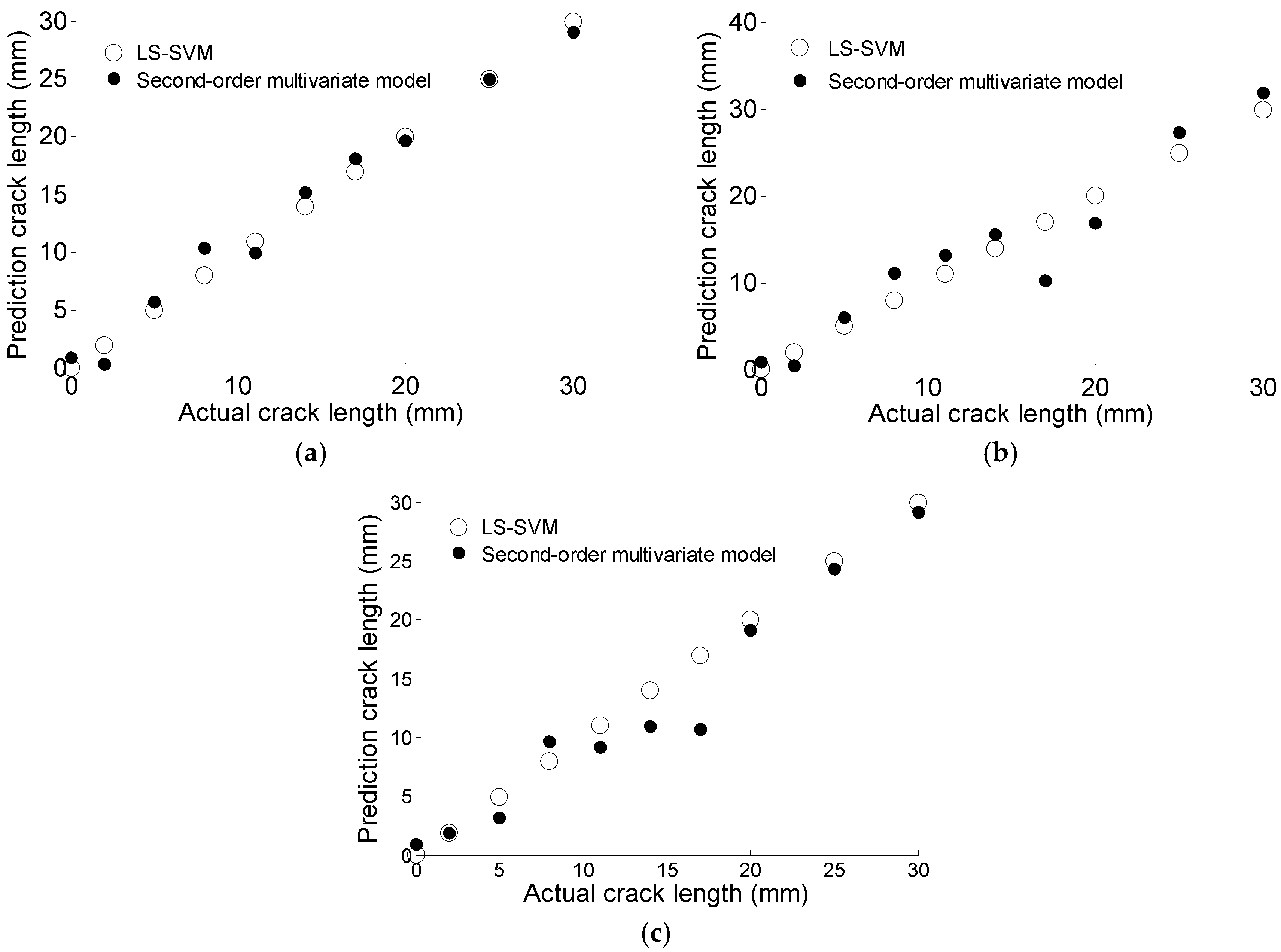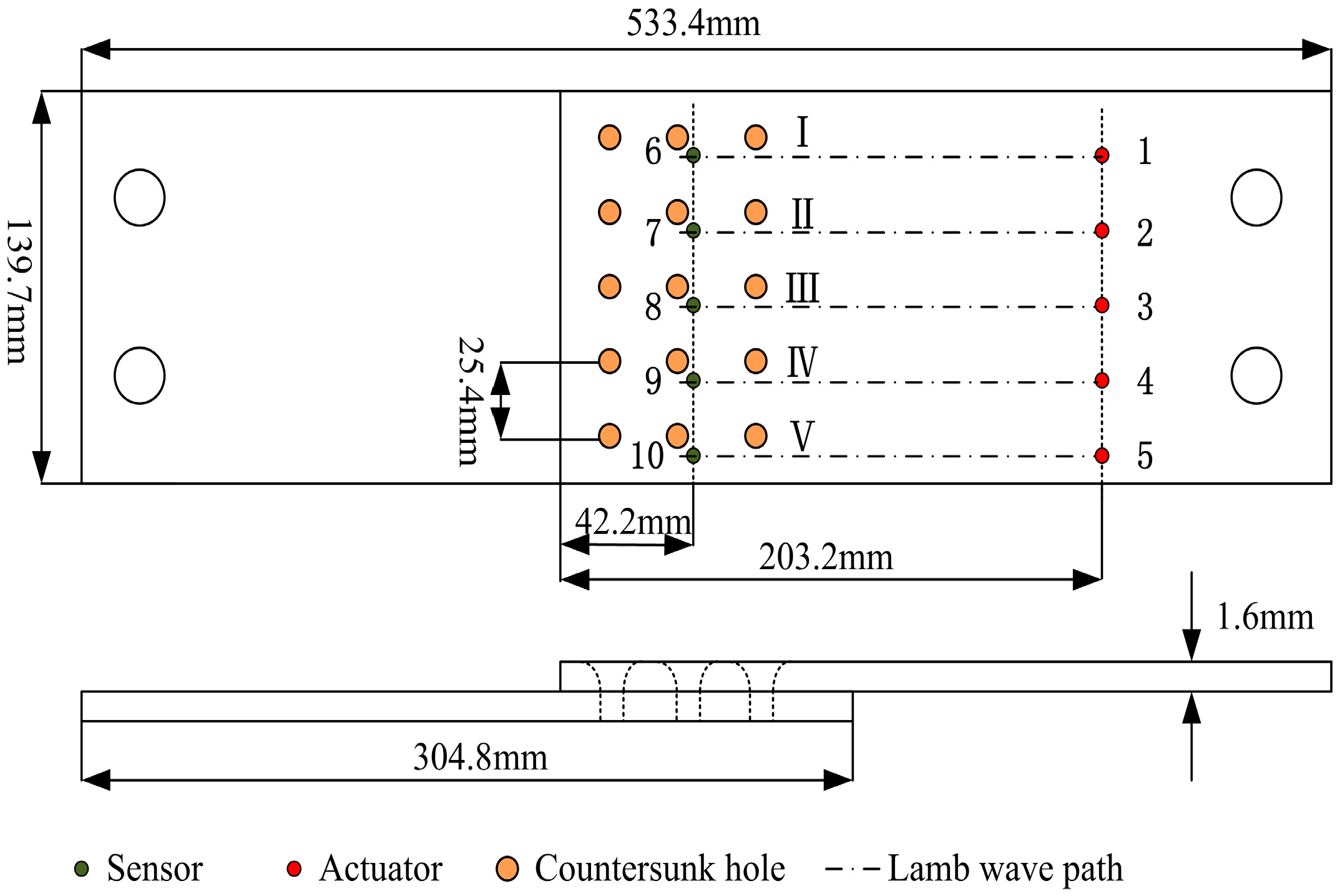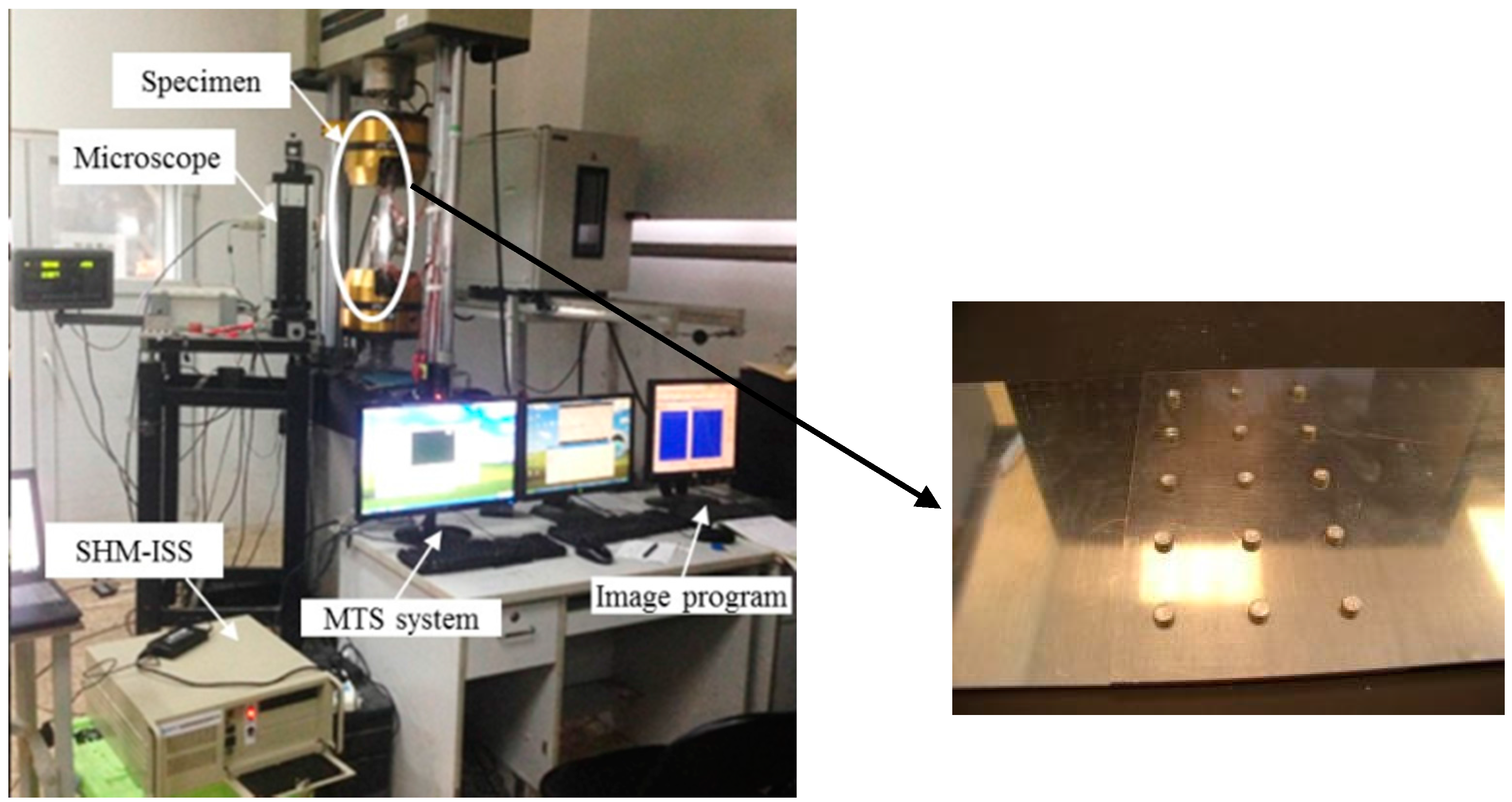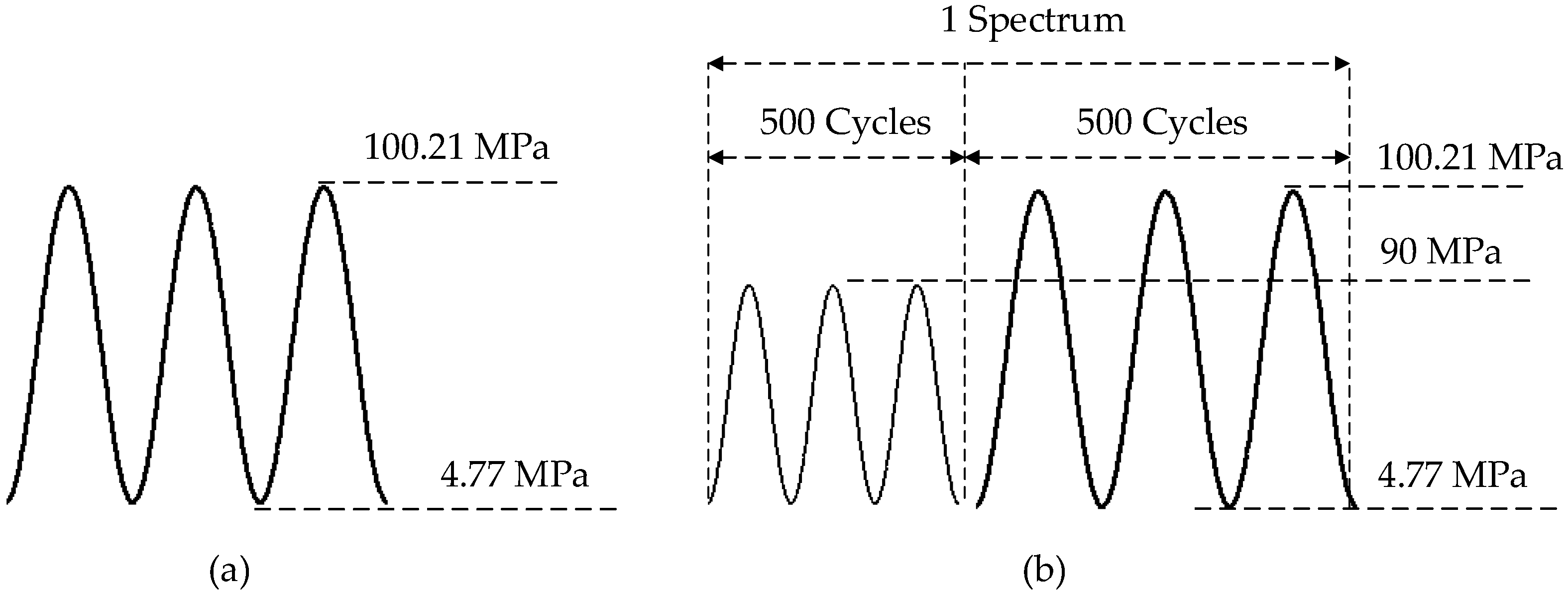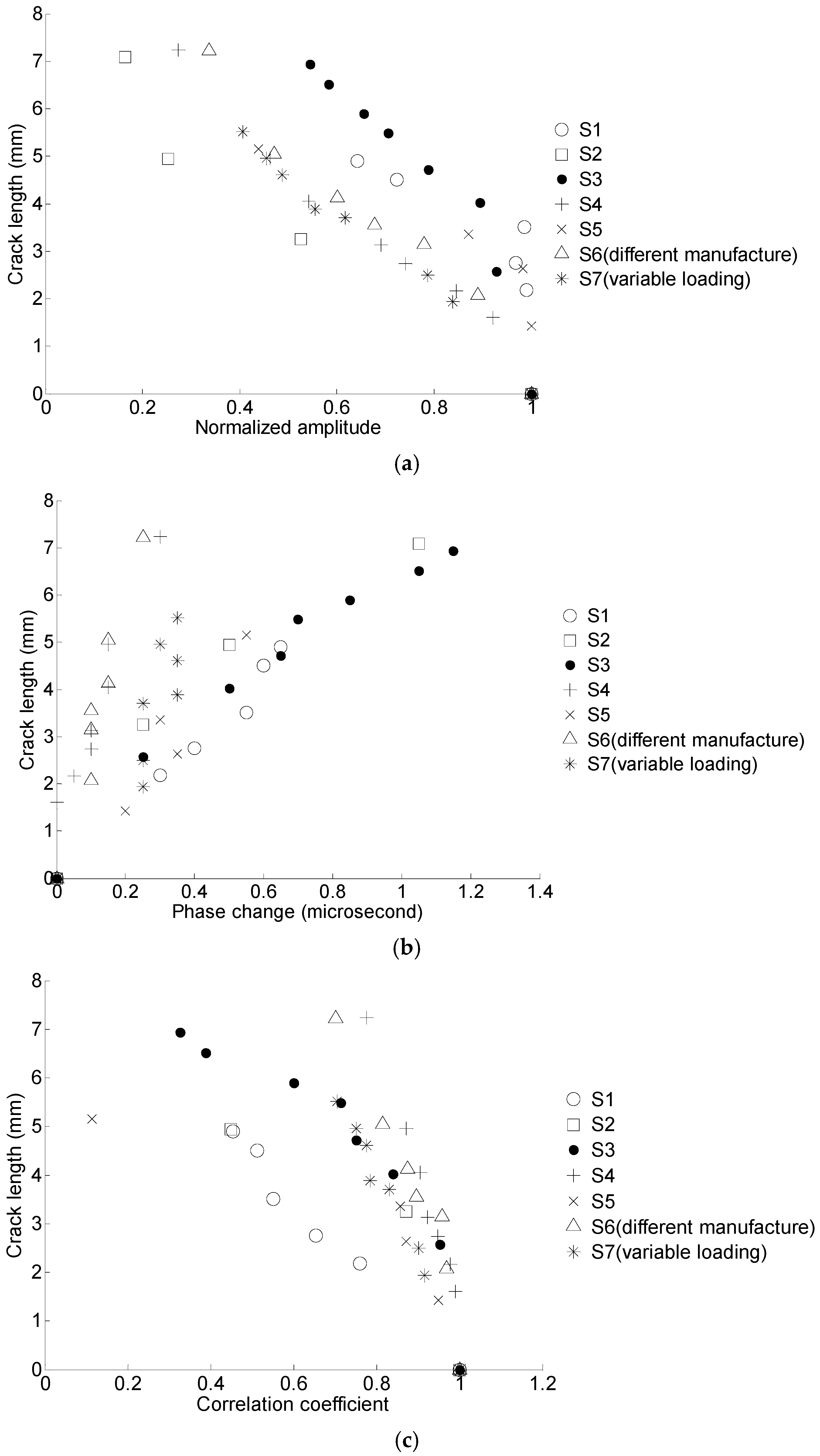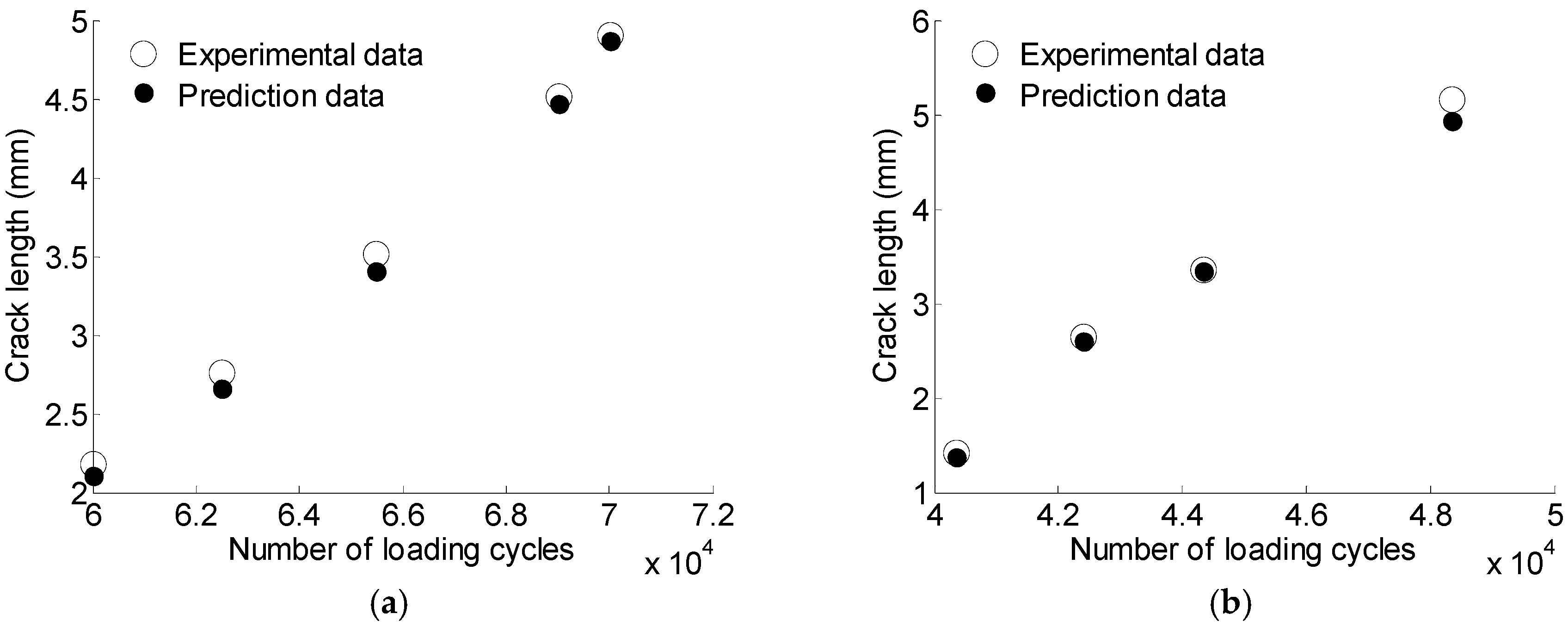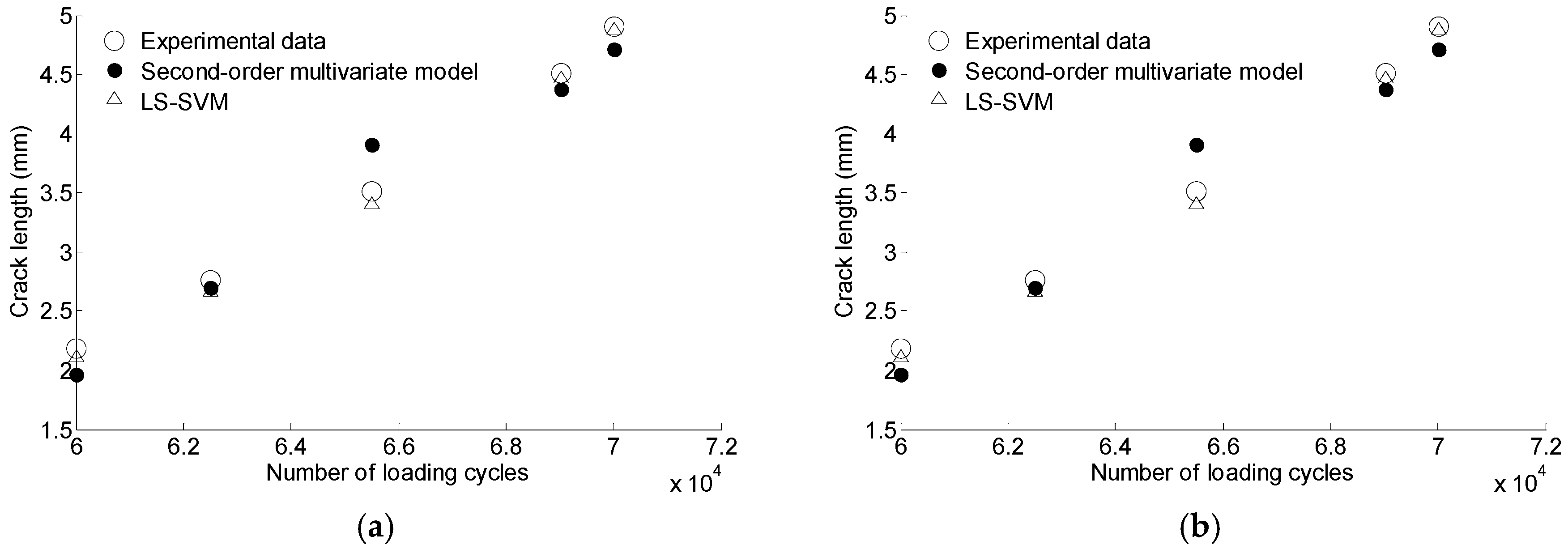Figure 1.
The overall framework of crack size quantitation using Lamb wave and genetic algorithm (GA)-based least square support vector machine (LS-SVM).
Figure 1.
The overall framework of crack size quantitation using Lamb wave and genetic algorithm (GA)-based least square support vector machine (LS-SVM).
Figure 2.
Dispersion curves of Lamb wave of a 2 mm aluminum plate.
Figure 2.
Dispersion curves of Lamb wave of a 2 mm aluminum plate.
Figure 3.
An excitation signal with 0.16 MHz.
Figure 3.
An excitation signal with 0.16 MHz.
Figure 4.
The mechanism of the group velocity and time window calculation.
Figure 4.
The mechanism of the group velocity and time window calculation.
Figure 5.
The illustration of the Lamb wave traveling through a damaged region.
Figure 5.
The illustration of the Lamb wave traveling through a damaged region.
Figure 6.
SVM for linear classification.
Figure 6.
SVM for linear classification.
Figure 7.
The nonlinear mapping from the input space to a high-dimensional feature space.
Figure 7.
The nonlinear mapping from the input space to a high-dimensional feature space.
Figure 8.
The flowchart of GA optimization for LS-SVM model parameters. MRE = mean relative error.
Figure 8.
The flowchart of GA optimization for LS-SVM model parameters. MRE = mean relative error.
Figure 9.
The geometry of the testing specimen and the layout of the piezoelectric (PZT) sensors. EDM = electric discharge machining.
Figure 9.
The geometry of the testing specimen and the layout of the piezoelectric (PZT) sensors. EDM = electric discharge machining.
Figure 10.
The testing equipment for the coupon test.
Figure 10.
The testing equipment for the coupon test.
Figure 11.
Experimental setup for the damage detection technique.
Figure 11.
Experimental setup for the damage detection technique.
Figure 12.
Crack length versus the damage sensitive features for six specimens. (a) Crack length versus the normalized amplitude; (b) crack length versus the phase change; (c) crack length versus the correlation coefficient.
Figure 12.
Crack length versus the damage sensitive features for six specimens. (a) Crack length versus the normalized amplitude; (b) crack length versus the phase change; (c) crack length versus the correlation coefficient.
Figure 13.
The optimization process using GA for model parameters.
Figure 13.
The optimization process using GA for model parameters.
Figure 14.
The prediction results using GA based LS-SVM. (a) T1; (b) T2; (c) T3.
Figure 14.
The prediction results using GA based LS-SVM. (a) T1; (b) T2; (c) T3.
Figure 15.
The comparison of prediction data based on second-order multivariate model and GA based LS-SVM. (a) T1; (b) T2; (c) T3.
Figure 15.
The comparison of prediction data based on second-order multivariate model and GA based LS-SVM. (a) T1; (b) T2; (c) T3.
Figure 16.
The geometry of the lap joint component and the sensor layout.
Figure 16.
The geometry of the lap joint component and the sensor layout.
Figure 17.
The fatigue crack experimental set up and the lap joint component.
Figure 17.
The fatigue crack experimental set up and the lap joint component.
Figure 18.
Fatigue loading spectra for lap joint components fatigue test. (a) Constant loading spectra for S1–S6; (b) variable loading spectra for S7.
Figure 18.
Fatigue loading spectra for lap joint components fatigue test. (a) Constant loading spectra for S1–S6; (b) variable loading spectra for S7.
Figure 19.
Crack length versus the damage sensitive features for seven specimens. (a) Crack length versus the normalized amplitude; (b) crack length versus the phase change; (c) crack length versus the correlation coefficient.
Figure 19.
Crack length versus the damage sensitive features for seven specimens. (a) Crack length versus the normalized amplitude; (b) crack length versus the phase change; (c) crack length versus the correlation coefficient.
Figure 20.
The optimization process using GA for model parameters.
Figure 20.
The optimization process using GA for model parameters.
Figure 21.
The prediction results for S1 and S5 using GA based LS-SVM. (a) S1; (b) S5.
Figure 21.
The prediction results for S1 and S5 using GA based LS-SVM. (a) S1; (b) S5.
Figure 22.
The comparison of prediction data based on second-order multivariate model and GA based LS-SVM. (a) S1; (b) S5.
Figure 22.
The comparison of prediction data based on second-order multivariate model and GA based LS-SVM. (a) S1; (b) S5.
Figure 23.
The prediction data for S6 and S7 using GA based LS-SVM. (a) S6; (b) S7.
Figure 23.
The prediction data for S6 and S7 using GA based LS-SVM. (a) S6; (b) S7.
Table 1.
Mechanical properties of the testing specimen.
Table 1.
Mechanical properties of the testing specimen.
| Material | Yield Strength (MPa) | Elastic Modulus (MPa) | σu (MPa) |
|---|
| Al2043-T3 | 360 | 72,000 | 490 |
Table 2.
Detailed information of the piezoelectric (PZT) (SM412) sensors.
Table 2.
Detailed information of the piezoelectric (PZT) (SM412) sensors.
| Properties | Value |
|---|
| Diameter | 7 mm |
| Thickness | 0.2 mm |
| Density | 7.80 g/cm3 |
| Charge constant d31 | −190 × 10−12 m/V |
| Charge constant d33 | 450 × 10−12 m/V |
| Relative dielectric constant | 1580 |
| Resonant frequency, fr | 300 kHz ± 10 kHz |
Table 3.
The extracted damage sensitive features of specimen T1.
Table 3.
The extracted damage sensitive features of specimen T1.
| Crack Length (mm) | Normalized Amplitude | Phase Change | Correlation Coefficient |
|---|
| 0 | 1 | 0 | 1 |
| 2 | 0.9616 | 0 | 0.9975 |
| 5 | 0.9657 | 0.1 | 0.9869 |
| 8 | 0.8620 | 0.2 | 0.9720 |
| 11 | 0.8051 | 0.2 | 0.9828 |
| 14 | 0.7753 | 0.3 | 0.9566 |
| 17 | 0.7931 | 0.4 | 0.9343 |
| 20 | 0.7647 | 0.5 | 0.9299 |
| 25 | 0.6799 | 0.5 | 0.8783 |
| 30 | 0.6592 | 0.6 | 0.8188 |
Table 4.
The regression parameters for the second-order multivariate model.
Table 4.
The regression parameters for the second-order multivariate model.
| A | α1 | α2 | α3 | α4 | α5 | α6 | α7 | α8 | α9 |
|---|
| −353.51 | 306.87 | 442.27 | 439.06 | −154.59 | −269.38 | −236.33 | −45.06 | −124.95 | −77.03 |
Table 5.
The comparison of predicted mean relative error (MREs).
Table 5.
The comparison of predicted mean relative error (MREs).
| Method | MRE (%) |
|---|
| T1 | T2 | T3 |
|---|
| GA based LS-SVM | 0.035 | 0.043 | 0.62 |
| Second-order multivariate model | 17.61 | 26.81 | 16.43 |
Table 6.
The optimized parameters for different training data and the prediction results.
Table 6.
The optimized parameters for different training data and the prediction results.
| Model | Training Data | Optimized Model Parameters | Validation Data | MRE (%) |
|---|
| γ | σ2 |
|---|
| 1 | T3, T5, T6 | 11.2237 | 0.1799 | T1, T2, T4 | 0.33 | 0.32 | 0.18 |
| 2 | T3, T4, T6 | 4.3775 | 1.0658 | T1, T2, T5 | 0.60 | 0.57 | 0.68 |
| 3 | T3, T4, T5 | 11.4494 | 0.1834 | T1, T2, T6 | 0.37 | 0.36 | 0.27 |
| 4 | T2, T5, T6 | 12.0009 | 1.0371 | T1, T3, T4 | 0.23 | 0.68 | 0.18 |
| 5 | T2, T4, T6 | 7.5269 | 1.0264 | T1, T3, T5 | 0.47 | 0.95 | 0.60 |
| 6 | T2, T4, T5 | 11.2422 | 1.0411 | T1, T3, T6 | 0.22 | 0.66 | 0.14 |
| 7 | T2, T3, T6 | 9.1589 | 1.1383 | T1, T4, T5 | 0.31 | 0.21 | 0.38 |
| 8 | T2, T3, T5 | 6.6729 | 1.0555 | T1, T4, T6 | 0.25 | 0.23 | 0.24 |
| 9 | T2, T3, T4 | 5.5657 | 1.0893 | T1, T5, T6 | 0.43 | 0.51 | 0.29 |
| 10 | T1, T5, T6 | 13.9066 | 0.0060 | T2, T3, T4 | 0.18 | 2.35 | 0.28 |
| 11 | T1, T4, T6 | 9.2120 | 0.0448 | T2, T3, T5 | 0.39 | 0.90 | 0.55 |
| 12 | T1, T4, T5 | 8.9821 | 0.9917 | T2, T3, T6 | 0.26 | 0.71 | 0.16 |
| 13 | T1, T3, T6 | 11.1999 | 0.0359 | T2, T4, T5 | 0.26 | 0.18 | 0.35 |
| 14 | T1, T3, T5 | 5.8298 | 1.0529 | T2, T4, T6 | 0.26 | 0.22 | 0.23 |
| 15 | T1, T3, T4 | 7.8652 | 1.1164 | T2, T5, T6 | 0.31 | 0.40 | 0.21 |
| 16 | T1, T2, T6 | 8.4133 | 1.0438 | T3, T4, T5 | 0.93 | 0.36 | 0.56 |
| 17 | T1, T2, T5 | 5.0177 | 0.9988 | T3, T4, T6 | 0.84 | 0.36 | 0.30 |
| 18 | T1, T2, T4 | 12.2764 | 0.9849 | T3, T5, T6 | 0.84 | 0.46 | 0.20 |
| 19 | T1, T2, T3 | 10.2852 | 1.1510 | T4, T5, T6 | 0.23 | 0.30 | 0.32 |
Table 7.
The regression parameters for the second-order multivariate model.
Table 7.
The regression parameters for the second-order multivariate model.
| A | α1 | α2 | α3 | α4 | α5 | α6 | α7 | α8 | α9 |
|---|
| 7.91 | −2.76 | −2.67 | −9.41 | 0.52 | −5.18 | 10.02 | 6.21 | 0.67 | 3.49 |
Table 8.
The comparison of predicted MRE for different methods.
Table 8.
The comparison of predicted MRE for different methods.
| Method | MRE (%) |
|---|
| S1 | S5 |
|---|
| GA based LS-SVM | 2.33 | 2.34 |
| Second-order multivariate model | 6.10 | 9.07 |
Table 9.
The predicted MRE of S6 and S7.
Table 9.
The predicted MRE of S6 and S7.
| Specimen | MRE (%) |
|---|
| S6 | 0.16 |
| S7 | 0.19 |
Table 10.
The optimized parameters for different training data and the prediction results.
Table 10.
The optimized parameters for different training data and the prediction results.
| Model | Training Data | Optimized Model Parameters | Validation Data | MRE (%) |
|---|
| γ | σ2 |
|---|
| 1 | S3, S4, S5 | 14.2149 | 0.0894 | S1, S2 | 4.29 | 5.11 |
| 2 | S2, S4, S5 | 12.3077 | 0.0065 | S1, S3 | 6.62 | 6.46 |
| 3 | S2, S3, S5 | 13.8345 | 0.1044 | S1, S4 | 3.09 | 1.84 |
| 4 | S1, S4, S5 | 11.7484 | 0.0464 | S2, S3 | 6.00 | 3.78 |
| 5 | S1, S3, S5 | 15.2365 | 0.3174 | S2, S4 | 6.32 | 1.36 |
| 6 | S1, S3, S4 | 15.7772 | 0.0188 | S2, S5 | 4.23 | 4.63 |
| 7 | S1, S2, S5 | 14.1009 | 0.0527 | S3, S4 | 5.03 | 4.73 |
| 8 | S1, S2, S4 | 14.7378 | 0.0765 | S3, S5 | 3.85 | 4.05 |
| 9 | S1, S2, S3 | 17.0275 | 0.0389 | S4, S5 | 4.45 | 5.01 |
Table 11.
The predicted MREs of S6 and S7 based on different training data.
Table 11.
The predicted MREs of S6 and S7 based on different training data.
| Model | Training Data | MRE (%) |
|---|
| S6 | S7 |
|---|
| 1 | S3, S4, S5 | 0.39 | 0. 34 |
| 2 | S2, S4, S5 | 2.68 | 3.78 |
| 3 | S2, S3, S5 | 1.62 | 0. 93 |
| 4 | S1, S4, S5 | 0.61 | 0.61 |
| 5 | S1, S3, S5 | 1.20 | 0.96 |
| 6 | S1, S3, S4 | 0. 80 | 0. 95 |
| 7 | S1, S2, S5 | 4.01 | 4.23 |
| 8 | S1, S2, S4 | 0. 54 | 0. 36 |
| 9 | S1, S2, S3 | 3.19 | 2.57 |
